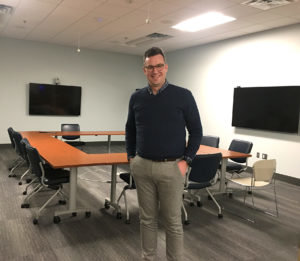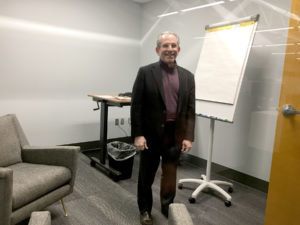By TESHA M. CHRISTENSEN
The floors in the new United Theological Seminary of the Twin Cities space in the Case Building are plain concrete, but the technology in the classrooms is state-of-the-art.
United Theological Seminary President Lew Zeidner explained that the seminary used its money on improvements that would directly benefit students rather than on fancy flooring.
Large offices for staff didn’t make the cut either. At the New Brighton campus, “I had an office that a family of six could live in,” pointed out Zeidner, who served on the seminary board for eight years before being hired as president in July 2016.
 Photo right: “For me, this is the kind of space contemporary students want to be in,” said United Theological Recruitment Specialist Silas Morgan. To serve their distance education students, each classroom has high-quality video cameras, microphones, speakers and screens so distance learners can more fully participate in classroom discussions. (Photo by Tesha M. Christensen)
Photo right: “For me, this is the kind of space contemporary students want to be in,” said United Theological Recruitment Specialist Silas Morgan. To serve their distance education students, each classroom has high-quality video cameras, microphones, speakers and screens so distance learners can more fully participate in classroom discussions. (Photo by Tesha M. Christensen)
That old model isn’t one that United Theological Seminary copied at its new space in the renovated Case Building (767 N. Eustis St., Suite 140). Designed by Doug Pierce, an architect with Perkins and Will, Zeidner’s office is like all other offices and includes a crank sit-stand desk. Several of the offices house two staff, so there are a few rooms—called huddle rooms—that are set aside for meetings and phone calls, or used when a staff member needs to spread out.
“We put maximum dollars in student education space and technology—into things that matter in the training of students,” said Zeidner. He said that if he needs more space, he can go into the library and be among students.
When designing the seminary, they worked to balance open and airy with the work they do dealing with tough issues and the emotions they bring up, Zeidner remarked.
Classes for the spring term began at the new campus on Jan. 14, for the seminary’s 122 students.
Space contemporary students want to be in
“For me, this is the kind of space contemporary students want to be in,” said United Theological Recruitment Specialist Silas Morgan as he gave tours before a public lecture on Feb. 8.
The former campus in New Brighton consisted of about five acres with four buildings, while the new space in the Case Building is 25,000 square feet.
Morgan observed that the old space was so large that not all of it was used, and things were very spread out. With the newer space, students gather in the intersection between the library, classrooms, dining area and chapel.
“There’s a very different form to the space, and it’s very functional,” observed Zeidner. “There’s a vibrancy.”
“We love it here,” added Gina Lotzer, who is assistant to the president. “It is so nice to see students in this space. You can feel the energy here.”
 Photo left: United Theological Seminary President Lew Zeidner stands in his simple office as he explained that the seminary used its money on improvements that would directly benefit students. (Photo by Tesha M. Christensen)
Photo left: United Theological Seminary President Lew Zeidner stands in his simple office as he explained that the seminary used its money on improvements that would directly benefit students. (Photo by Tesha M. Christensen)
A key feature of the new building is the Innovation Lab, a space for student projects from podcasts to artistic expressions of faith. Under the leadership of the Reverend Karen Hutt, a United vice president with responsibility for innovation, this lab will serve as a space for speakers and series, such as “The Art of…” series, and focus on topics such as improvisation and conflict resolution. According to Hutt, they also plan to serve the community by opening the lab and other parts of campus to caregivers and change makers who are seeking a place where they can be refreshed and re-energized for their work.
There are three classrooms, a conference room, computer area, “living room,” and several break-out rooms, as well as a mother’s room/meditation space and archive room.
To serve their distance education students, each classroom has high-quality video cameras, microphones, speakers and screens so distance learners can more fully participate in classroom discussions. Recognizing that learning takes place outside the classroom, the 25% of seminary students who are distant learners can also participate in student and faculty conversations in student huddle rooms, the Innovation Lab and even the dining area thanks to technology placed there.
While the library did downsize to accommodate a more compact footprint, most of the books came with to the new space and are stored on racks that can be rolled out and expanded.
Large windows allow lots of natural light, and there are also skylights and urban green space.
Practical ministry training
Ministry has changed significantly since United Theological Seminary of the Twin Cities opened its doors in 1962. Founded by the United Church of Christ as an ecumenical seminary serving all Protestant denominations, today’s leaders recognize that faith leadership requires more than theological understanding. Whether seminary students become ministers, chaplains or nonprofit executives, they also must develop innovative, financially viable programs to address the needs of the populations they serve.
The staff believes that this new location in St. Anthony, near the Green Line, University Ave., Highway 280 and Interstate 94, will provide many opportunities for students to be involved in social justice work.
“This positions us right in the middle of the city,” observed Morgan.
“Religious leaders need to be comfortable outside of church buildings, working within diverse communities ministering to the needs of people in everyday settings,” said Zeidner. “Our new campus and innovation focus will ensure that students develop strong practical ministry leadership skills in ways that are well integrated with their rigorous academic training.”
Comments
No comments on this item Please log in to comment by clicking here